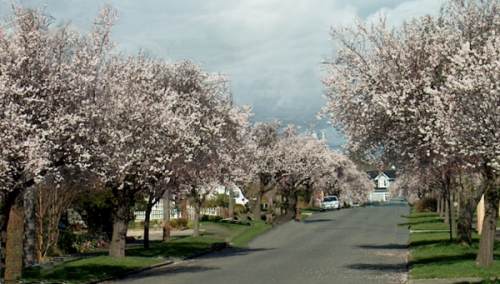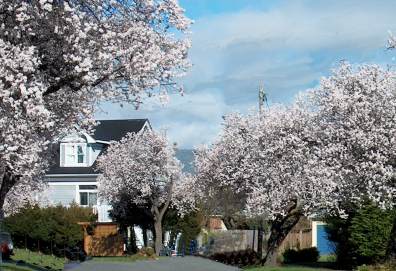 |
 |
| Home | Welcome | What's New | Site Map | Glossary | Weather Doctor Amazon Store | Book Store | Accolades | Email Us |
 | |||||||||
Weather Almanac for March 2003SPRING'S NORTHWARD MIGRATIONSpring comes early to those of us residing in and around Victoria, British Columbia, located on the southeast tip of Vancouver Island. We annually revel in its early appearance and gloat over our good weather fortunes as the "Canadian Tropics" by taking an annual blossom census in late February while our continental Canadian cousins still freeze and shovel snow. The regular early onset of Spring can be credited, in part, to our mild winters, a gift from the relatively warm waters of the winter Pacific Ocean lapping our shoreline. This year's El Niño conditions have likely advanced the blossom emergence ahead of that experienced in more "average" years. As I write this in late-February, we have yet to experience a day this winter with maximum temperature below the freezing mark, and very few of our morning lows have registered more than a degree or two of frost.  I first noted the emerging cherry blossoms in my neighbourhood during February's first week, but friends living along the southern areas of town — about five kilometres distant — assure me many cherry trees there were already in full bloom. By Valentine's Day, the street outside my window was lined with white-blossoming cherry trees. In my nine years at this location — five kilometres from the shoreline and some 60 metres above sea level — I have noticed that the boulevards lined with cherry trees burst into colour as a slow flood tide moving from the shore to my part of town, creeping a few blocks every day. That is Spring's migration here in Greater Victoria, but it is not the only one taking place. Each year, for example, Spring begins to migrate northward along the eastern/Atlantic regions of North America from the ever-warm reaches of south Florida to the Canadian Maritime Provinces, eastern Quebec and New England. While the media appear to want Spring to start "on the dot" with the Equinox, nature does not work that way. Not all seasonal rhythms follow precise clocks, even if the planet's orbital position does. Most often, they build and recede across continental areas like the flow and ebb of ocean tides. Spring illustrates this tide perfectly because it has such dramatic, visible indicators in the season's changing flora and fauna. Though Spring's northward migration does not advance with the speed of a warm front, its climatological advance is very apparent to nature watchers. New plant life emerges or blossoms, and animals migrate, hatch or emerge from winter's sleep as the season advances. Studies have established that Spring migrates northward along the coast of eastern North America at about 27 kilometres per day (17 miles per day) at sea-level. Thus, if red maples bud in Washington, DC on March 20th, the trees in Baltimore should bud two days later, and New York City's red maples bud two weeks hence. This rate only applies to Spring's sea-level advance northward at sea level. Spring must also climb the terrain, doing so at a rate of around 30 metres (100 feet) of altitude per day. Therefore, once Spring arrives in the valley, it will finally reach the top of a 300m (1000-foot) ridge ten days later. We learned of this northward migrating tide even before regular and widespread measurements of weather conditions began in the Nineteenth Century. Much of that knowledge of the advance of Spring came through long-term observations of surrogate climate indicators: plants and animals. Such study constitutes a branch of science known as phenology. The Science of Phenology
Phenology is a prime example of what important scientific information can be produced by simple observation and record keeping — though the first "phenologists" likely had no interest in science, they did it to assure a full belly. All it really takes to be a phenologist are good senses for observation and a diary or journal to record them. Any one of the many cycles in the living world can be watched and recorded in a date-keeping journal to start a phenological study. Among the most popular examples for study are:
Over a number of years, these records provide clues to the timing of biological cycles, such as those applicable to hunting, gathering and agriculture. Today, we base many similar decisions, such as the expected harvest date, on observed weather data and computer models. Our forefathers and foremothers watched the natural world around them for such decision-making signs. Phenology is an old science. There are written records from as early as 974 BCE, but the first phenological studies likely came early in human evolution. To a large extent, early human survival was linked with the ability to understand and act upon the clues given by seasonal changes around them. The ability to make the right decisions based upon phenological observations might have been the difference between life and death.
Carolus Linnaeus, the founder of our plant/animal classification and naming system initiated the first systematic phenological studies. In 1750, he selected 18 sites in his native Sweden and made yearly observations of the dates of leaf opening, flowering time, fruiting and leaf fall, together with records of the weather conditions. While anything in the biosphere that has regular recurring rhythms is a prime candidate for phenological study, other regular natural events can also be watched for clues of regularity. In weather, the dates of last snow or last frost of Spring; first snow or first frost of Autumn; or the dates a local lake or pond freezes in the Fall or opens in the Spring are candidates for study. The ancient Egyptians, for example, found the flooding of the Nile River came annually around the time when Sirius, the Dog Star, rose just before the Sun. Hopkins Law of BioclimaticsEarlier, I gave a value for the march of Spring northward along the North American East Coast and upwards with elevation. Those figures were first derived by America's leading forest entomologist during the first part of the 20th century: Andrew Delmar Hopkins. When Hopkins looked at the phenological records for Virginia and West Virginia, he found a relationship between the coming of spring and a site's elevation, latitude and longitude. Applying this further afield, he discovered that in North America, the further west, or north, or higher in elevation from the Atlantic Coast a site was, the later spring arrived. The relationship, today known as Hopkins Law of Bioclimatics, found spring advances one day for every 15 minutes of latitude northward, 1.25 days for each degree of longitude westward, and one day for every 30 metres higher in elevation. Thus, for a site located 15 minutes of latitude north, one degree west and 60 metres higher than another chosen site, Spring should arrive 4.25 days later. Phenology and Climate ChangePhenology can also provide us with important information about climate change, at least giving us an independent marker from temperature measurements as to whether that change is or is not occurring. By comparing data from past studies with those of today, bioclimatologists are seeing changes in the timing of biological events indicative of changing climate in many parts of the world. For example, spring flowering in Alberta is now as much as ten days earlier than it was 45 years ago. British researchers report that the first flowering in the Spring of 385 British plant species has advanced between 4.5 days and 55 days in the last decade compared with the flowering date of those species over the four decades 1954-1990. The first flowering date in the 1990s advanced by an average of 15 days for 16 percent of the studied species. The greatest advance in the flowering date came with the white dead nettle: 55 days. The lengthening of the warm growing season can have a different effect on those plants that depend on the number of "cool days" for their dormancy. Many of these plants now bloom much later in the season as they need those extra, later-Spring cool days as initiators. As a check on the hypothesis of a warming climate, those plants that base their flowering on the length of daily light and dark cycles, rather than on temperature levels, are showing no significant movement of their blossom dates. While such studies cannot distinguish between climate warming caused by natural global climatic cycles or by human impacts on global climate, they do tell us we are currently in a warming period. Final WordsThe arrival of Spring, as indicated by plants and animals, or even meteorological measurements, does not mean that wintry weather will not return. Very often there are short-term setbacks and occasionally extreme relapses back to winter weather. And, it is rare that the indicator suddenly appears with the first burst of Spring weather. What is indicated is that a lengthy or consistent stretch of favourable. Spring-like weather has occurred. As Spring advances across the continent, you can observe the march of nature in your own home area. You might be interested in beginning phenology as a pastime this year (and not just for spring events). Just pick some event such as the first leaves, or buds, or first robin's song and jot the date observed down. Next year, watch again for that event and see if it is earlier or later. Another fun activity would be to find an event occurring south or at lower elevation than your location and then see how long it takes for the event to reach you. Then you will have seen Spring's Northward Migration.  Written by
|
|||||||||
 |
To Purchase Notecard, |
Now Available! Order Today! | |
 |
 |
NEW! Now |
The BC Weather Book: |


